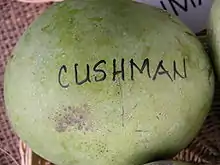| Mangifera 'Cushman' | |
|---|---|
 Display of 'Cushman' mango at the Redland Summer Fruit Festival, Fruit and Spice Park, Homestead, Florida | |
| Genus | Mangifera |
| Species | Mangifera indica |
| Hybrid parentage | 'Haden' × 'Amini' |
| Cultivar | 'Cushman' |
| Origin | Florida, USA |
The 'Cushman' mango is a mango cultivar that originated in south Florida. The variety had limited to no commercial application but has been sold as a dooryard tree.
History
The original tree grew from a seed planted in 1936 on the property of E. L. Cushman, in Miami, Florida. For many decades afterward its parentage was unknown, but a 2005 pedigree analysis suggested that the cultivar was likely a cross between Haden and Amini.[1] The fruit was recognized as having excellent eating quality, but the trees were poor bearers making the cultivar undesirable for commercial production. Cushman was also known as the 'Big Yellow'.
Cushman trees are planted in the collections of the USDA's germplasm repository in Miami, Florida,[2] the University of Florida's Tropical Research and Education Center in Homestead, Florida,[3] and the Miami-Dade Fruit and Spice Park,[4] also in Homestead.
Description

The fruit is round in appearance and yellow when ripe, often looking more like a grapefruit than a mango.[5] The flesh is pale yellow, completely fiberless, and has a sweet, rich flavor and aroma. The fruit averages over a pound in weight, getting up to 2 pounds, and contains a monoembryonic seed. The flesh has a distinctive characteristic in that when sliced open, Cushman fruit have a visible orange "halo" outlining the flesh closest to the skin. The fruit mature from July to August in Florida.
The trees are vigorous growers with spreading canopies of medium density.[6]
References
- ↑ Olano, Cecile T.; Schnell, Raymond J.; Quintanilla, Wilber E.; Campbell, Richard J. (2005). "Pedigree analysis of Florida mango cultivars" (PDF). Proc. Fla. State Hort. Soc (118): 192–197. Archived from the original (PDF) on 18 June 2010. Retrieved 16 April 2017.
- ↑ "Mangifera indica L. 'Cushman'". Germplasm Resources Information Network (GRIN). Beltsville, Maryland: USDA, ARS, National Genetic Resources Program. Archived from the original on 20 July 2012. Retrieved 16 April 2017.
- ↑ "TREC Tropical Fruit Collections" (PDF). University of Florida Institute of Food and Agricultural Sciences. p. 3. Archived from the original (PDF) on 8 April 2018. Retrieved 16 April 2017.
- ↑ "Plant and Tree List 2008". Friends of the Fruit and Spice Park. Archived from the original on 9 August 2011. Retrieved 16 April 2017.
- ↑ Campbell, Richard J. "Mango Cultivars". Virtual Herbarium. Archived from the original on 2 December 2010. Retrieved 16 April 2017.
- ↑ Campbell, Richard J. (1992). A Guide to Mangos in Florida. Fairchild Tropical Garden. p. 51. ISBN 0-9632264-0-1.